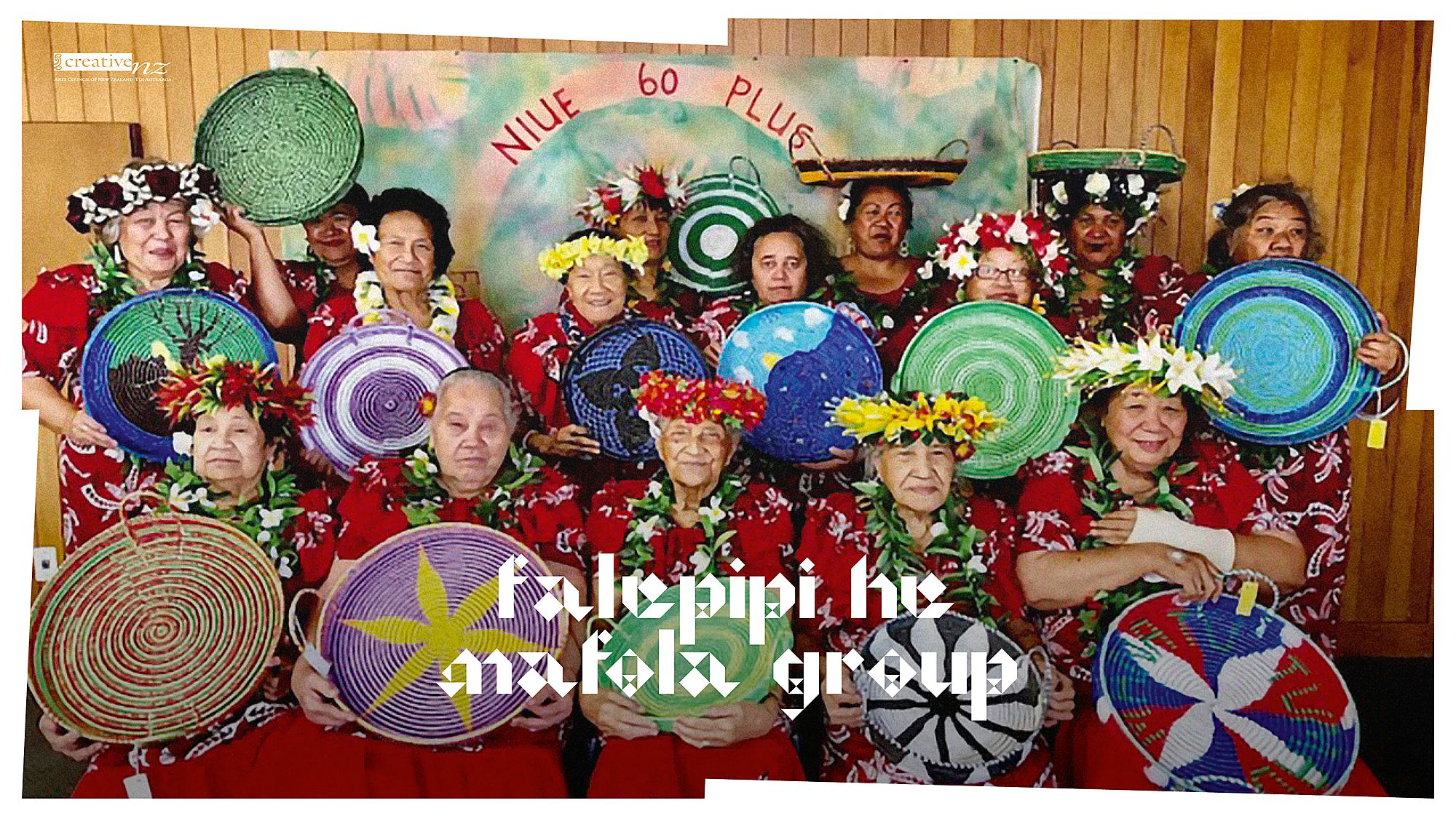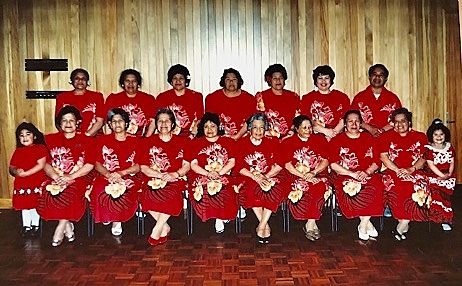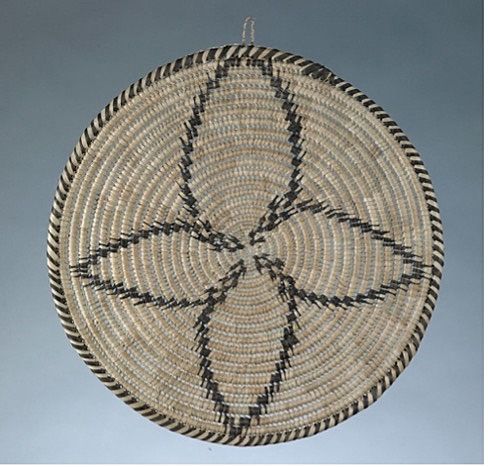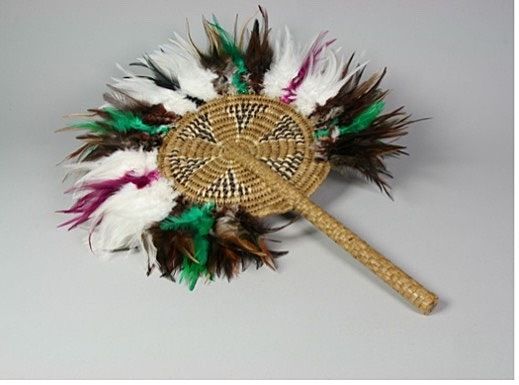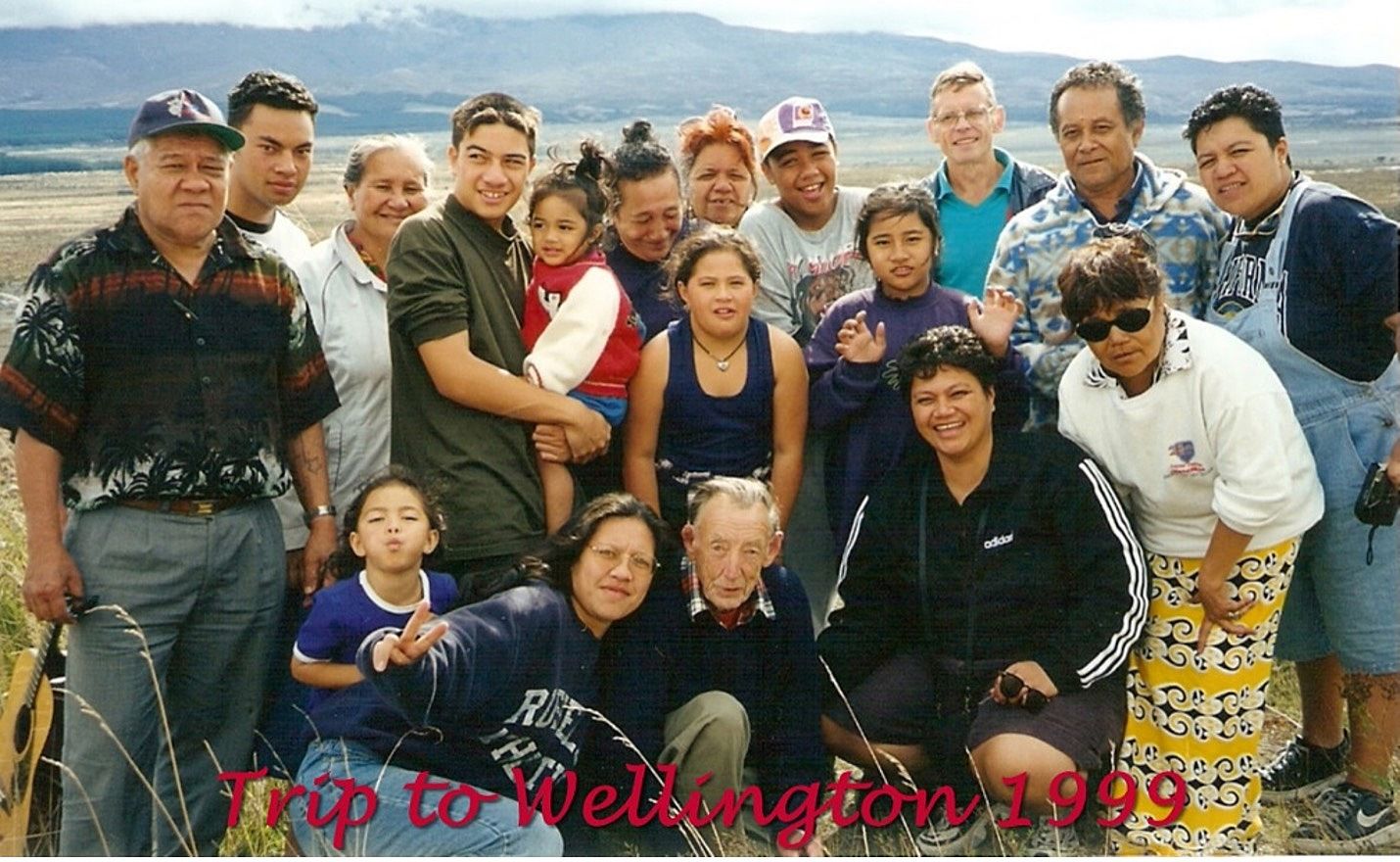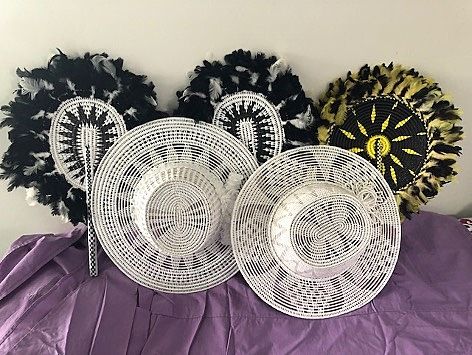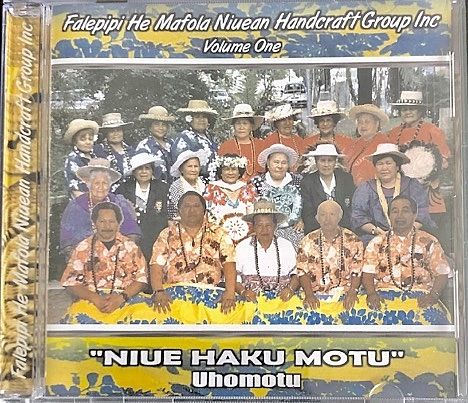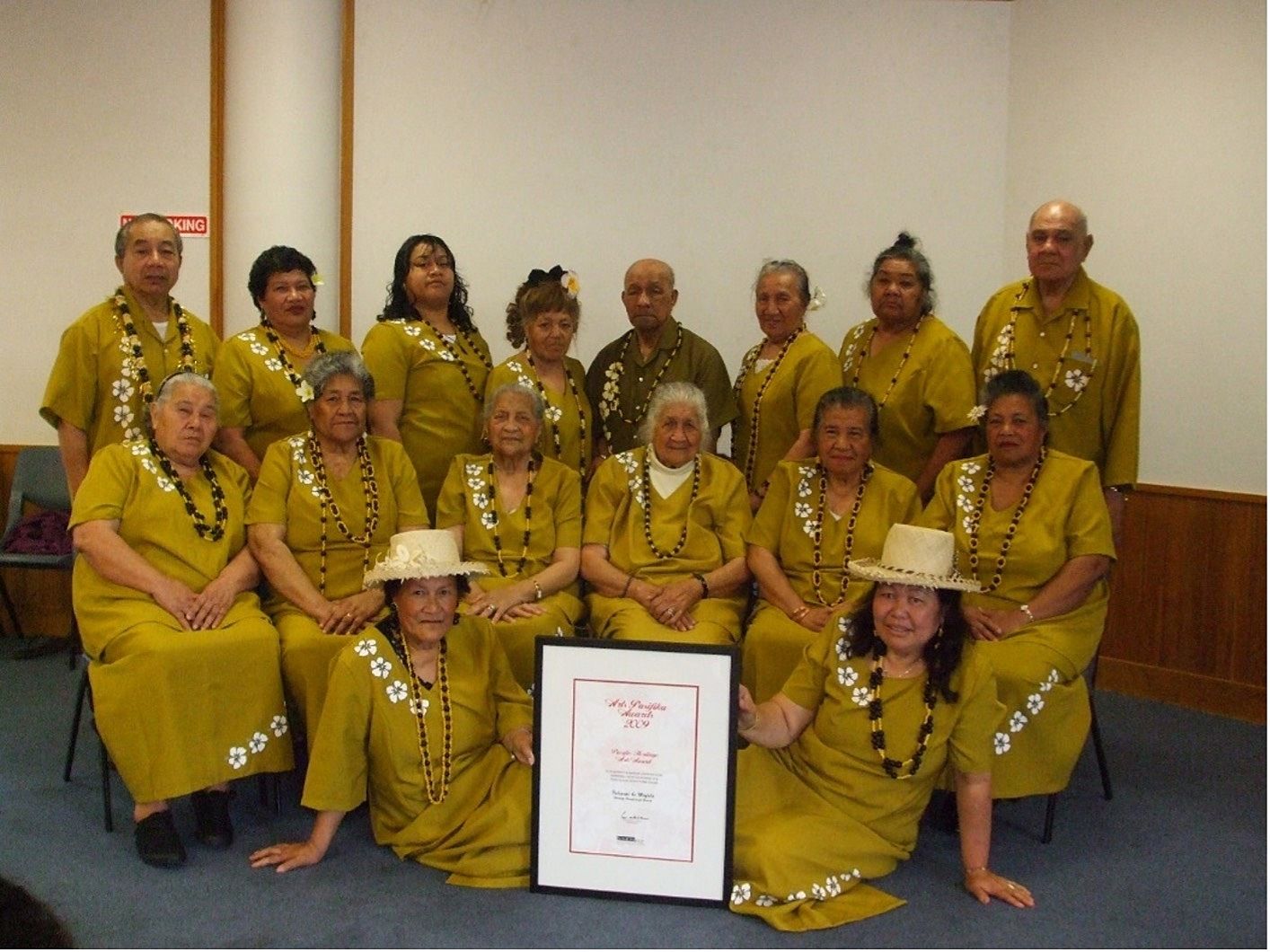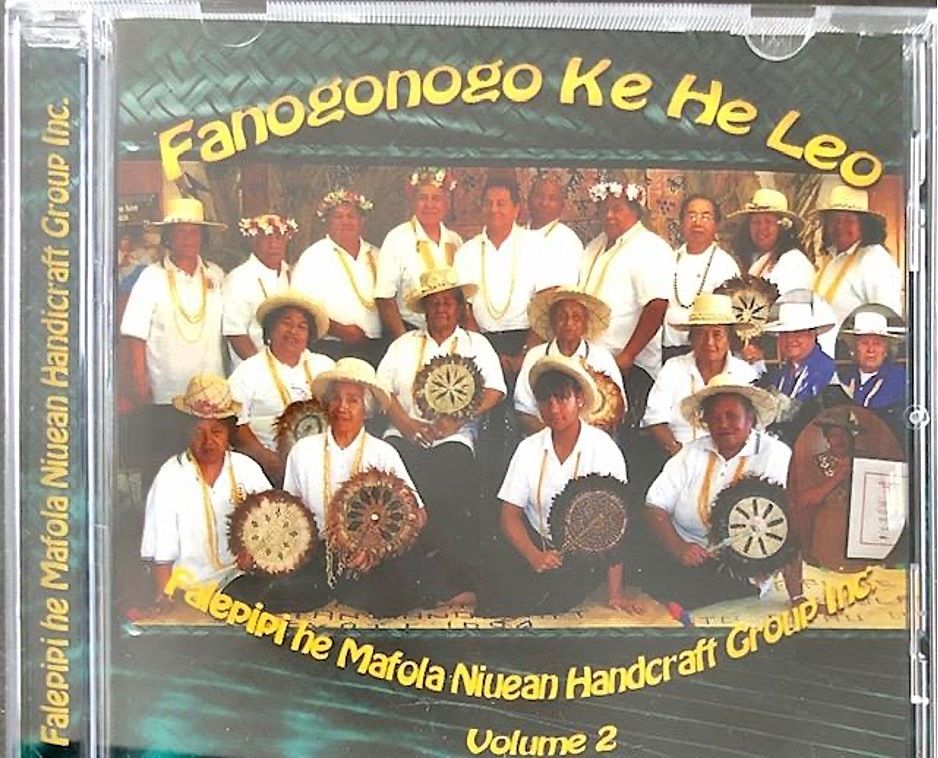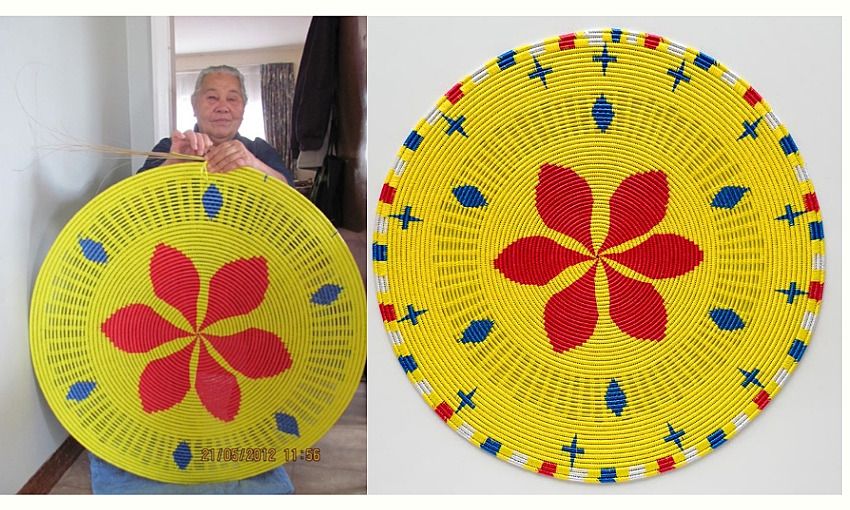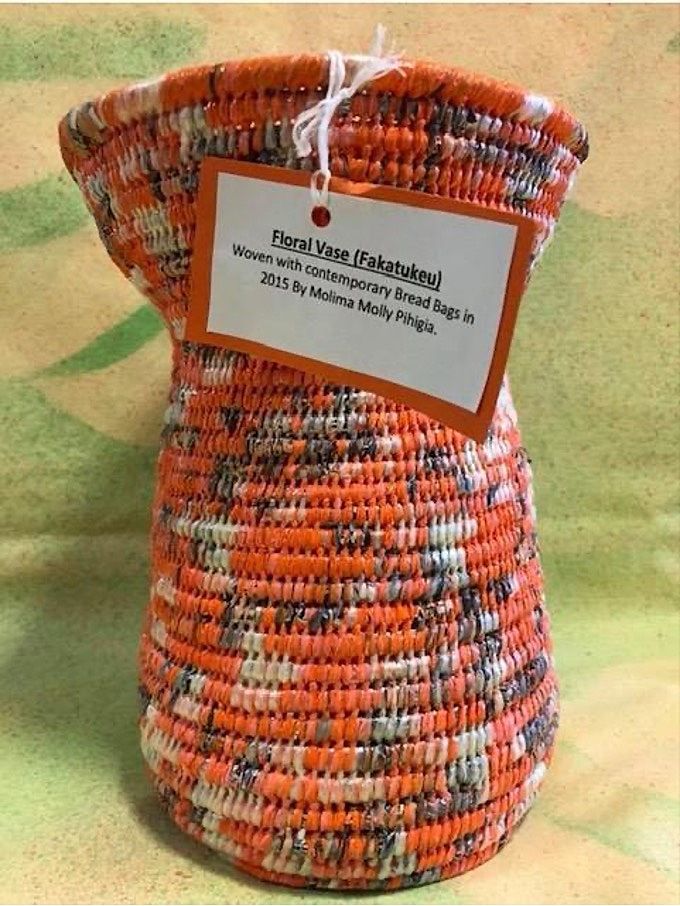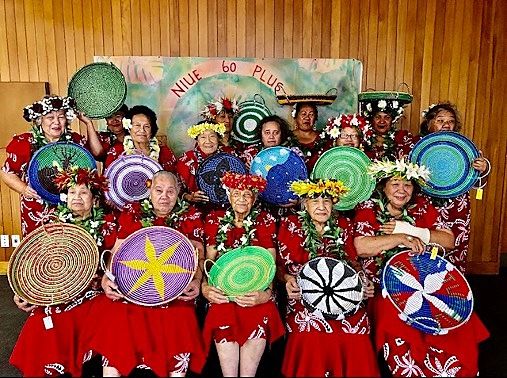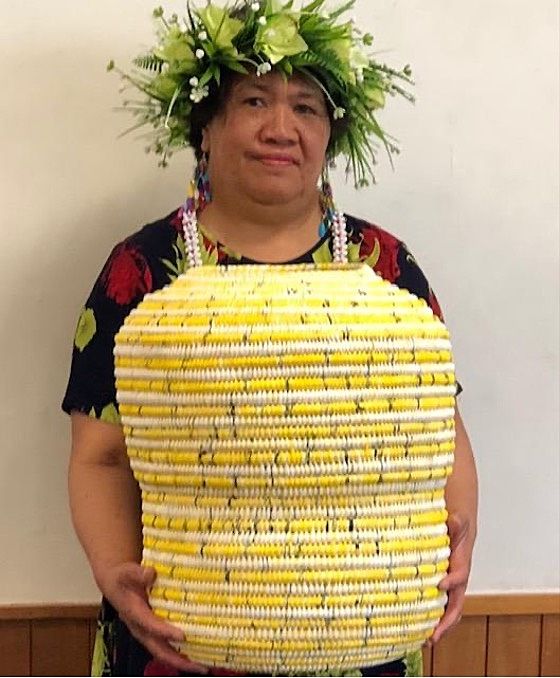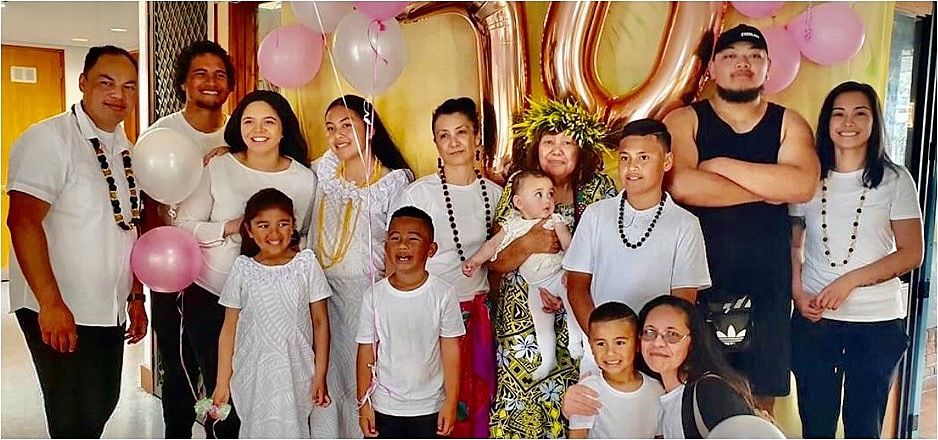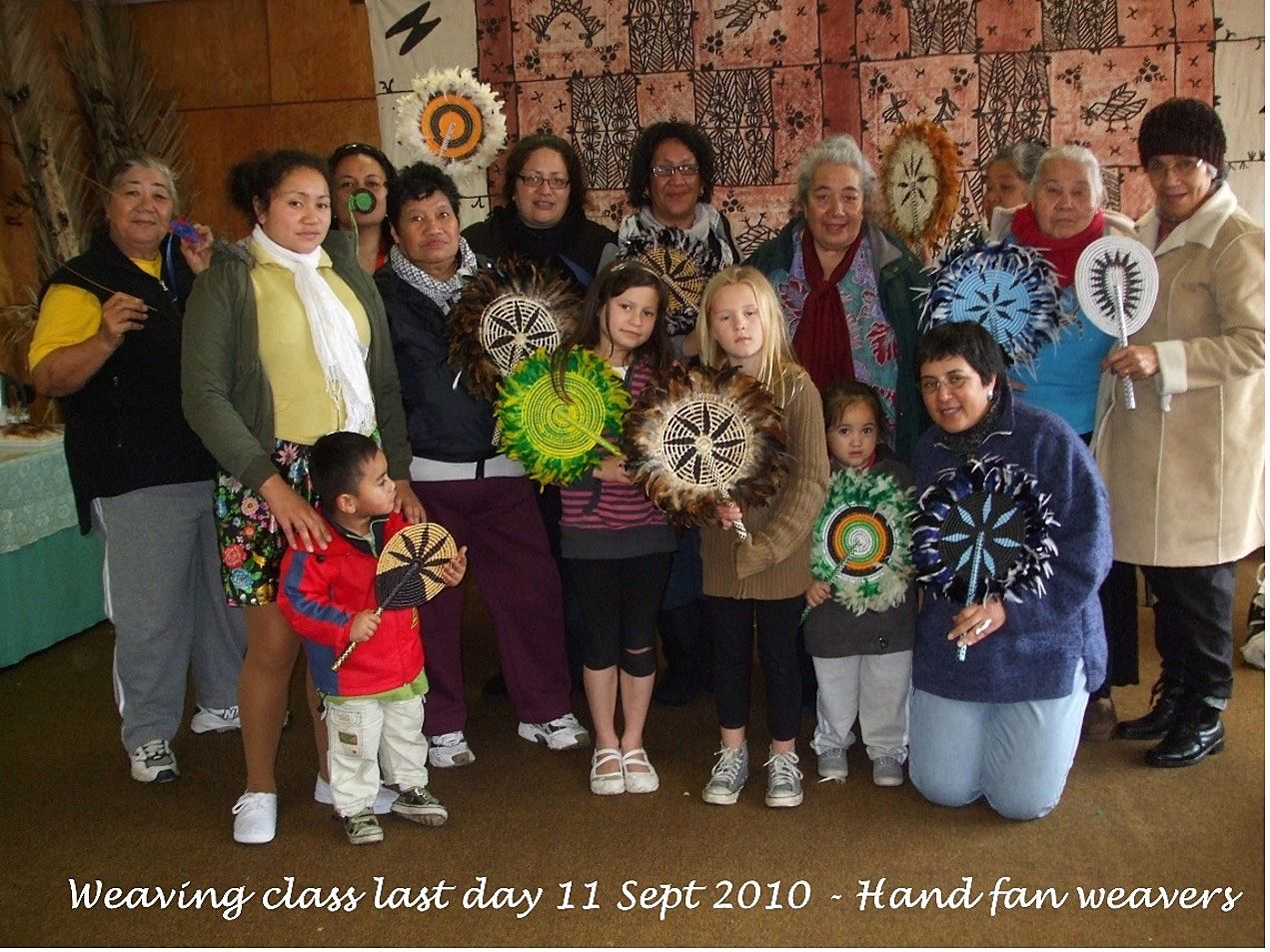Falepipi he Mafola – A House of Peace
Molima Molly Pihigia shares her insight as a founding member of Falepipi he Mafola: the award-winning Niuean handicraft group bringing together a community of older persons.
We’re collaborating with Creative New Zealand to bring you the ground-breaking Pacific Arts Legacy Project. Curated by Lana Lopesi as project Editor-in-Chief, it’s a foundational history of Pacific arts in Aotearoa as told from the perspective of the artists who were there.
Lagi-Maama Academy & Consultancy are honoured to have been brought on by Creative New Zealand to connect with Moana Oceania cultural practitioners as part of this Pacific Arts Legacy Project. We were humbled to share time–space with Molima Molly Pihigia over two lunchtime talanoa(talking critically yet harmoniously) at one of our favourite Ōtāhuhu eateries, Ōtāhuhu Food City, in Tāmaki Makaurau Auckland. While enjoying our tom yum Thai soup we shared with Molima about the project, answered her queries, talked through approaches she might want to take, and then left it with her to decide on what she wanted to focus on. This is what she gifted – a beautiful insight into her creative knowledge and practice as a founding member of the Falepipi he Mafola group.
Our ancestors before us laid a foundation for all generations to follow and prosper wherever we choose to live, and today I pay tribute to their knowledge and wisdom.
The Falepipi he Mafola Niuean Handcraft Group Inc. was set up on 1 April 1993 and became an incorporated society on 19 August 1994. At that time there was a need for older persons to prolong their wellness and independence by being part of a community group. The group has been meeting at the Ōtāhuhu Town Hall, Ōtāhuhu, Auckland, every Thursday from 10am to 2pm since 1993 and continues to this very day.
My name is Molima Molly Pihigia, QSM, and I’m a founding member of the Falepipi he Mafola group, together with my late husband Fataiki Pihigia. I was brought up in Talikifea, Alofi, and migrated to Aotearoa New Zealand in February 1970, at the age of 19. I spent 17 years living in Wellington and moved to Auckland at the end of 1990. For 50 years, Aotearoa has been my second home, and here I worked in the health sector for 35 years, mainly in aged care and the community.
Falepipi he Mafola foundational members in 1994. Back row, L-R: Olive Makahili, Malia Ikitule, Lotomoka Fanovaha, Taela Lavakula, Manatagaloa Palalagi, Molima Molly Pihigia, Fataiki Pihigia. Front row, L-R: Faithlynn Palalagi, Hakehakehekafa Togiaheulu, Siliona Atofia, Hana Sila, Sosaiete Havar, Nefe Liakimatagi, Aotagaloa Mitipelo,Malamahetoa Tohovaka, Tiresa Fasi, Losalina Walter.
My husband and I went to the Pasifika Festival in Western Springs in March 1993, which the Auckland Council facilitated, and from there a passion grew in our hearts to start a group for older persons. It was sparked by the joy of seeing Pacific heritage arts, from cultural performances to the colorful heritage artworks. We communicated with women from our village of Tuapa Uhomotu about setting up a group for older generations so they could meet during the week, and this is how the Falepipi he Mafola group was set up. The founding members come from Niue, especially from Tuapa Uhomotu, and some from Alofi, Makefu, Liku, Namukulu, Hikutavake, Tamakautoga and Mutalau.
Falepipi he Mafola – A House Binding in Peace
The selection of a name for the group was very important. We held a meeting where nominations were put in a hat and the selection made. The majority were in favour of ‘Falepipi he Mafola’ and with great honour, the group was called Falepipi he Mafola Niuean Handcraft Group. I would like to acknowledge the historical background of the name Falepipi he Mafola. The information I am sharing is from members of the group and also from the matua (elders) of Tuapa Uhomotu.
In the past, Niue was divided into two regions. The northern region was called Motu and the southern region was called Tafiti. During that time there were many battles between the warriors of Motu and Tafiti. As the battle went on for years, warriors began to make connections for change. The leaders agreed to end all fighting amongst themselves and discuss unity. As the leaders on both sides discussed and planned, their thoughts were more favoured on erecting a first meeting house so they could all have a place to gather together. The meeting house was built at Fatuaua, Tuapa Uhomotu, Niue, and called Falepipi he Mafola, meaning ‘The house of peace’. The building is no longer standing today, but the historical foundation remains on the land, at Tuapa Uhomotu. I vividly remember as a young child visiting my grandmother Fiahau Lagigie, who comes from Tuapa Uhomotu, on my bush bike. My late husband also came from Tuapa Uhomotu and he was a village leader in Auckland for many years in the Pacific Islands Presbyterian Church, in Newton.
This photo was taken in 2004 at Fatuaua, Tuapa Uhomotu, Niue. The Falepipi he Mafola foundation still stands where the coconut trees are.
Service
My 28 years of serving the Falepipi he Mafola group has been very rewarding and beneficial. I was 43 years old when I started managing the affairs of Falepipi he Mafola with the governing board. To start and manage a community group of older persons is a great passion in my heart, to ensure our older generation’s wellbeing is taken care of. When employment days for our older generations end, ageing becomes a challenge, but regular participation in Falepipi he Mafola strengthens the daily needs of an older person and their family. The cultural practices and programmes run by the group contribute to our older persons adjusting to the new environment of no longer working, and the ageing process.
It is important to have a group where our ageing population can meet regularly, and enjoy outings and each other’s company, fulfilling their needs and bringing greater joy to their lives.
Falepipi he Mafola started mainly for any older person and their family to cultivate and maintain their identity as a Niuean living in Aotearoa. In Niue we were brought up in a village setting with protocols, values and beliefs. But now we live in Aotearoa, where we learn to adjust, with great respect for Tangata Whenua and all ethnicities. It is important to have a group where our ageing population can meet regularly, and enjoy outings and each other’s company, fulfilling their needs and bringing greater joy to their lives.
Looking back
Throughout our 28 years, Falepipi he Mafola has kept a good collection of data on our vision; knowledge shared and exchanged; achievements in maintaining our cultural practice; living and adjusting to a new country; strengthening our Niuean families; and ageing in Aotearoa.
1999 – Wellington
In 1999, our group took a bus trip to Wellington for the Easter weekend. It was a wonderful time as some of us had never been to Wellington. It was a time of meeting Niueans who have lived for years in that region. We met them at Porirua hall on Saturday during the Niuean activities and then joined them for Sunday service in Newtown Pacific Islanders’ Presbyterian Church. We also performed at Te Papa and it was fantastic. Some of the works that we gifted Te Papa are now part of their collections.
Lili (wall hanging) by Tiresa Fasi. Source: Pacific Cultures Collection, Te Papa
Iliili (fan) by Molima Molly Pihigia. Source: Pacific Cultures Collection, Te Papa
On our bus trip back to Auckland we stopped for sightseeing on the Desert Road, at Mt Ruapehu, and took this picture. Back row, L-R: Andrew Osikai, Maunulisi Simeki, Malamahetoa Tohovaka, Sialemene Nevalagi, Nicholas Havar, John Nevalagi (bus driver), Siale Talagi. Middle row, L-R: Fasivihi Lanifole, Jonathan Nevalagi, Miss Talagi, Losalina Walter, Miss Talagi. Front row, L-R: Haylee Esela, Hannah Osikai, Wallace Anderson, Pola Cook, Sosaiete Havar.
2000 – Niue
On Christmas 2000, Falepipi he Mafola went to Niue on a holiday for two weeks. It was a wonderful trip for everyone, as a lot of families brought their grandchildren for the first time to see where their ancestors came from. For some of the men and women, it was their first trip back since they came to Aotearoa. We thoroughly appreciated the hospitality of Tuapa Uhomotu, hosting us with great honour as guests in the village hall, Falepipi he Mafola. We performed and displayed our Aotearoa artwork made with raffia, which included white church hats and hand fans.
White raffia hats and hand fans similar to this were used when we went on our trip to Niue in 2000. Back row, L-R: Maline Ikiua (black and white fans), Sisi Makakona. Front row, L-R: Maunulisi Simeki, Foufili Halagigie.
2005 – First CD launch
In 2005, Falepipi he Mafola decided to launch our first CD, with ten Niuean songs and two hymns, called Niue Haku Motu Volume 1.
Back row, L-R: Soaiete Havar, Mokamua Wallace, Tiloa Noue, Taela Lavakula, Sisi Makakona, Malamahetoa Tohovaka, Olive Malahili, Peti Vasa, Manatagaloa Palalagi. Middle row, L-R: Heleni Tamatoa, Tiresa Fasi, Salona Kuki, Hakehakehekafa Togiaheulu, Maunulisi Simeki, Molima Molly Pihigia. Front row, L-R: Hoi Pelesitama, Jolly Talima, Malia Ikitule, Togia Vasa, Fataiki Pihigia.
2009 – CNZ Pacific Heritage Art Award
In 2009 it was a great honour for Falepipi he Mafola to receive a Pacific Heritage Art Award from Creative New Zealand. Heritage art is who we are, as Pasifika people celebrating our heritage in language, music, dancing, singing, weaving, storytelling and much more. The Falepipi he Mafola group travelled to the Waitakere City Council Chambers for the celebrations on 13November 2009.
This photo was taken on 26 November 2009 at the Ōtāhuhu Town Hall. Back row, L-R: Fataiki Pihigia, Ivona Puleosi, Ioana Teokotini, Sosaiete Havar, Malamahetoa Tohovaka, Taela Lavakula, Kuimaka Lakau. Middle row, L-R: Foufili Halagigie, Manatagaloa Palalagi, Olive Makahili, Heleni Tamatoa, Malia Ikitule, Peti Vasa. Front row, L-R: Hakehakehekafa Togiaheulu, Molima Molly Pihigia.
2010 – Second Falepipi he Mafola CD
In 2010, Falepipi he Mafola recorded our second CD, as an acknowledgement of the Creative New Zealand Pacific Heritage Art Award that we proudly received in 2009. The CD has 12 traditional Niuean songs, and was funded by CNZ and a Lottery Community grant.
Back row, L-R: Hakehakehekafa Togiaheulu, Saaga Tamatoa, Harry Mokalei, Kuimaka Lakau, Henry Eveni, Pita Polima, Jolly Talima, Fataiki Pihigia, Molima Pihigia, Taela Lavakula. Middle row, L-R: Enatuleni Polima, Manatagaloa Palalagi, Olive Makahili, Malia Ikitule, Sifa Parkatama, Foufili Halagigie. Front row, L-R: Sosaiete Havar, Maline Ikiua, Cerian Eveni, Peti Vasa.
2012 – Home AKL exhibition
In 2012, one of the best master weavers of our group, Foufili Halagigie, wove a lili fakamanaia (wall hanging) for the Home AKL: Artists of Pacific Heritage in Auckland exhibition (7 July – 22 October 2012) at Auckland Art Gallery Toi o Tāmaki. Foufili comes from Tamakautoga and joined the group in 1998 with her daughter and son. She brings many beautiful talents to the group.
Left: Foufili Halagigie weaving her lili fakamanaia, 21 May 2012. Right: Completed lili fakamanaia, in the collections of Auckland Art Gallery Toi o Tāmaki.
2012 – DVD acknowledging our matua
In 2012, Falepipi he Mafola recorded a DVD called Ko e Moui he Nofo I Aotearoa [Ageing in Aotearoa]: Ata Talahau Tala, as an acknowledgement of our Niuean elders, reflecting on ageing in Aotearoa. We had 26 elders between the ages of 60 and 85 years from the Niuean community take part to tell their stories and what it is like to grow older in a new country. It was a project proudly funded by ASB Community Trust (now Foundation North).
*
2013 – Weaving stories
As a leader who has worked with Falepipi he Mafola since it was set up, my passion continues to grow. In 2013, I took our weaving practice to another level by weaving stories, especially on wall hangings. The materials we use are contemporary raffia and kaniu (coconut mid-ribs), which are much easier to obtain. The traditional laufa (pandanus) is very awkward to send over from Niue to Aotearoa. In 2020, Falepipi he Mafola was closed during the Covid-19 lockdown period but we continued our weaving of lili fakamanaia (wall hangings) at home. Sadly, this will be our reality of living with Covid-19, so keeping our members engaged and working on projects in their own homes is key until we can safely gather again. I made the lili fakamanaia below, telling the story of how I saw things in 2020.
Lili whakamanaia (wall hanging) by Molima Molly Pihigia, 2020.
2015 – Kaniu and bread bags
Weaving is therapeutic and very good for recreational purposes. Our group’s weaving project in 2015 involved using kaniu (coconut mid-ribs) and bread bags. When the bread was all eaten, the bags were collected and we cut them up into strips for weaving. Using plastic bread bags is a great way of recycling and it gives a very effective and colourful pattern at no cost at all. The only cost was the kaniu, which we bought from Ōtāhuhu shops from $8 to $12 for a tafi or salu (broom). For this project I made this floral vase, woven with bread bags and kaniu.
Floral vase by Molima Molly Pihigia, 2015.
2018 – Celebrating 25 years
In 2018, to celebrate our 25 years of serving the Niuean community, we had a tray weaving project that was funded by Creative Communities, Auckland Council. The image shows members of our group with the trays they each made.
Back row, L-R: Mokahele Halagigie, Tulei Tatoa, Tui Mitiepo, Fapasi Tuhega. Middle row, L-R: Molima Molly Pihigia, Hakehakehekafa Togiaheulu, Olika Taole, Helen Jackson, Milifeoaki Patumaka, Taela lavakula. Front row, L-R: Enita Vakatau, Foufili Halagigie, Olive Makahili, Malia Ikitule, Snow Touna. Absent: Vaosa Peni Ikiua, Senelita Taviliniu, Sifa Parkatama, Harry Parkatama, Maka Pilokolu, Faea Pilokolu.
2019 – Weaving with plastics
In 2019, one of our very talended weavers, Mokahele Halagigie, ran workshops on how to weave with plastics. The image below is a clothing basket made by Mokahele using Pak‘nSave shopping bags combined with white rubbish bags. She demonstrated how to cut bags into strips before weaving them with kaniu (coconut mid-ribs). Mokahele is the daughter of one of our group’s master weavers, Foufili Halagigie, and the intergenerational passing on of knowledge is very strong between this mother and daugther.
A clothing basket made by Mokahele using Pak‘nSave shopping bags combined with white rubbish bags.
Clothing basket by Mokahele Halagigie, 2019.
2020 – Queen’s Service Medal
In 2020, Covid-19 disrupted many families in Aotearoa with our lockdown and Alert Levels 4, 3, 2 and 1. It was a hard time for everyone, and I want to say thank you for the nomination for a Queen’s Birthday Honours award. And I am truly honoured to have received the Queen’s Service Medal on 1 June 2020, for service in the community and Niuean heritage art. The photo below was taken at the Ōtāhuhu Town Hall on 31 October 2020 with my children, grandchildren and great-grandchildren, celebrating the award and my 70th Birthday.
Back row, L-R: Andrew Osikai, Winitana Fotofili, Haylee Fotofili, Yasmine Osikai, Ruisa Anderson, Molima Molly Pihigia holding baby Sia Hannah Fotofili, Diego Osikai, Junior Osikai, Latoya Faifua. Front row, L-R: Monique Osikai, Tyson Mane, Ezra Mane, Hannah Osikai.
Our families and friends contribute a lot and support Falepipi he Mafola with our programmes, projects, exhibitions and events, and I value their contribution. Every year, we have a Christmas breakup lunch and are often joined by our families, where we acknowledge all of their volunteer services for our group.
Present and future
In my time with the group I have observed the talents and skills of the weavers during our projects. I was fascinated to learn the belief system of some weavers as they are very protective over their talents and not willing to pass knowledge down to anyone. The way we are brought up is very unique – as a child, if you really want to learn how to weave then it’s entirely your choice to start learning to weave a matalili, which is a small table mat.
I see a need for us to develop the sustainability of our intergenerational relationships.
As I closely observe and reflect on our group’s journey, I see a need for us to develop the sustainability of our intergenerational relationships. The sharing and imparting of Niuean cultural knowledge, values and beliefs is very important for both our ageing and younger Niuean generations.
The weaving classes I have run with young New Zealand-born Niueans over the past seven years have created high interest, and they have been very keen to learn Niuean weaving. I believe the intergenerational sharing of knowledge in this area will lead the younger ones to develop their skills, and when they retire from their working years they will have some good skills in their baskets.
Weaving class with young New Zealand-born Niueans in 2010.
My dream and vision for Falepipi he Mafola is to continue, excel and be a service promoting and maintaining Niuean heritage art. We all live in the Auckland area and the only way we see each other is when we come to the group to celebrate our Niuean heritage. The Covid-19 pandemic has made it very hard for older people to travel to the group, which is really sad. They are at the stage where they need to get dropped off and picked up.
In 2020, during the Covid-19 lockdown, I applied for funding through the Ministry for Pacific Peoples; Community Covid-19 Fund and we received funding towards a book called Hidden Talents – TaleniI Tanumia. The members and families of the group were given the opportunity to share their experiences over the Covid-19 pandemic and lockdown in Auckland. It was a wonderful journey, which encouraged literacy amongst our group so that our beautiful stories could be heard and written.
The Covid-19 pandemic has made it very hard for older people to travel to the group, which is really sad.
My time with Falepipi he Mafola has brought so much joy through many experiences of working with past and present members, the Niuean community and churches, funding agencies, health services, TOA Pacific Inc., Adult Community Education, Creative New Zealand, Auckland Council Local Boards, Ōtāhuhu Town Hall, Auckland ethnic communities and the Ōtāhuhu Library.
Our legacy
As the years go by we learn to adjust when group members pass away, and more than 30 loved ones have gone before us. I acknowledge their wonderful contribution to Falepipi he Mafola; their sharing of skills, love and values is very much appreciated. We all need faith to strengthen and empower each other with the word of God. Our bodies, minds and souls definitely need balance so that we can cope well with our responsibilities. We now only have three existing founding members, aged 90, 80 and 70, and we are grateful for the new members who came with great passion to join us. We value our time together and that’s the best part of connecting. At the moment some of the members are unable to attend for health reasons but they love home visits from leaders of the group.
As the years go by we learn to adjust when group members pass away, and more than 30 loved ones have gone before us.
Before ending my sharing about the Falepipi he Mafola group, I want to thank Creative New Zealand for a wonderful opportunity to be part of their Pacific Arts Legacy Project, and the team capturing the living stories and rich histories of our Moana Oceania (Pacific) artists and leaders who have made huge impacts and contributed significantly to the cultural landscape of Aotearoa and beyond. Our great respect and acknowledgement go to Lagi-Maama Academy & Consultancy for accepting the Falepipi he Mafola group as one of the ten master artists.
As I am writing, I rejoice and thank our heavenly Father, for I know I can’t do this alone. It is timely, and the guidance of our great Provider helps the writing of a unique story so members, families, the Niuean community and friends of Aotearoa may know another beautiful Pasifika heritage art-form from Moana Oceania.
Finally, I thank my late husband, Fataiki Pihigia, our four children, seven grandchildren and four great-grandchildren for their wonderful support in being there throughout the 28 years of serving the needs of our people. Fakaue lahi kia monuina – Kitu Kitu Kitu Ea.
*
This piece is published in collaboration with Creative New Zealand as part of the Pacific Arts Legacy Project, an initiative under Creative New Zealand’s Pacific Arts Strategy.
Lana Lopesi is Editor-in-Chief of the project.
Series design by Shaun Naufahu, Alt group.
